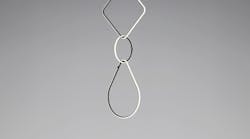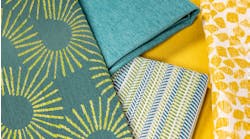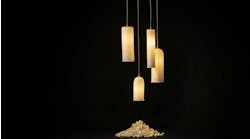On March 15, 2018, lighting company FLOS announced the launch of the long-awaited modular lighting collection Arrangements. Designed by Michael Anastassiades and previewed during Salone 2017, the innovative line fashions itself after jewelry.
Completely customizable, the collection features nine fixture elements composed of aluminum and LEDs. Each element can be arranged and rearranged to create a multitude of combinations.
interiors+sources sat down with the designer Michael Anastassiades to discuss the collection.
interiors+sources: What was the inspiration for the product?
Michael Anastassiades: [I wanted to create] a lighting system in which people would have the option to compose and create their own chandelier. This idea of giving creativity back to the user was quite an interesting kind of subject.
It's almost like giving somebody a pencil and asking them to draw in the blank space. This idea of “how do you make your first mark?” was quite an interesting concept for me that I decided to expand on. Last year we launched in Milan the Arrangements collection, which is a take on that idea but in a different way. In this case, there's different geometrical light elements, like forms—basic forms—that can be combined in a configuration. A user can purchase these elements individually and link them up to create their own chandelier.
i+s: How many different designs are there?
MA: We have the loops, which come in three sizes, the horizontal bar, the diamond shape--which is the square in two sizes--the teardrop shape, and a right angle which is basically two straight lines coming to a right angle. All of these elements can be combined with each other.
i+s: How is it powered?
MA: It is a low voltage system. The transformer that holds to the ceiling is hidden behind a canopy. By linking up the elements, it simply carries the current from one element to the next.
i+s: When did you start working on this product?
MA: We started working on Arrangements in the summer of 2015. Then we launched it in Europe in 2017 and a year later it went out on the market, which is now.
i+s: What was the most difficult part of creating this product?
MA: I think the whole magical thing is the delicate sections the different elements have. They look like they're just simply hung from each other and they literally are. To solve that technologically has been kind of difficult and to make them look so effortless. You can take one element out and add another element or do something completely different. You could combine all the different elements separately and keep them and compose and change as you like. The interesting challenge [is] to make them look effortless somehow.
i+s: How would you describe the initial response to Arrangements?
MA: It's been really incredible. It's the sort of product that you need to really see live to appreciate. I think it's one of those products that is not so photogenic because it communicates something. Also, seeing it turned on, is definitely quite magical. The fact that it is a fully customizable fixture means you really need to see it to appreciate it to the full extent.
i+s: Is this going to be more like an accent piece or can you light an entire space?
MA: In terms of the output and how much light it makes: it's a lot of light there. I have one of the product types above my dining area, and it's only two small elements. I have it in half of intensity, so I've got the dimmer down to half, and it's still too bright. So there's a lot of light. But I'm a person that doesn't like things to be too bright; even at 50 percent is just more than enough to illuminate the whole space.
i+s: What are your guests’ responses when you have people over and they see this prototype above your dining room table?
MA: It's amazing because they get mesmerized; it's almost like there has been a kind of magic trick done. It just pulls them. It’s magnetic, let’s say. This has been a pleasant surprise that something that could be so linear, direct, and graphic could become quite meditative.
i+s: What are some of the other surprises you’ve gotten over the course of creating Arrangements?
MA: The biggest challenge is always the glow because I think this is what makes a light. When I design a light, I think of the glow. I imagine what the glow is like and I think the biggest challenges have been to achieve that glow. Because you can draw things and you can imagine things and you can sketch things and shapes and forms and say, “This is how I'd like it to be” but the most important thing is how the piece glows. How does it actually mimic the light? How does it communicate? And this is the starting point for me.
Throughout the process, I think the biggest surprise came when we finally managed to reach that level because of course, it was a struggle in the first year of development. We were trying to identify technologies that would give me the effect that I was after. And then finally I remember sort of walking into the R&D department and there it was; the fixture was turned on and I was completely mesmerized by this object that I had designed. It was like a magnet that kind of pulled me to it. I stood there and stared at it. I never imagined that it was going to have that quality.



